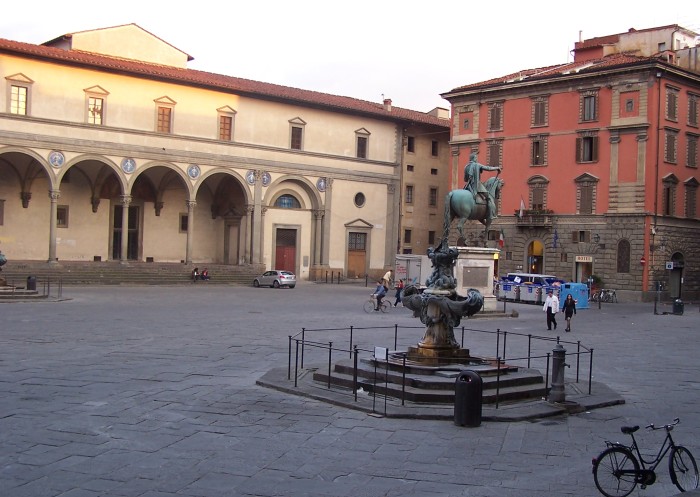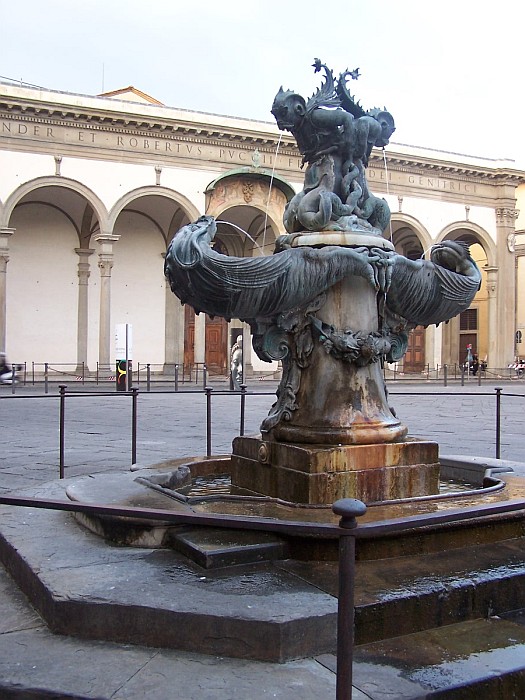(Italian pronunciation: pyah-tsah sahn-tee-see-mah ah-noon-tsee-ah-tah)


New Year's in March? That's right. Up until 1582, Europe rang in the New Year on March 25, the Feast Day of the Annunciation. According to Christian tradition, the Annunciation commemorates the moment that the Archangel Gabriel came to the Virgin Mary to announce the birth of Jesus on March 25, exactly nine months before Christmas. In Florence, the feast coincided nicely with the arrival of spring, to which a local proverb was dedicated: ‘Per l'Annunciazione la rondine è arrivata; e se un'né arrivata, l'è per strada o è ammalata!' (‘The swallow arrives for the Annunciation; and if he hasn't yet arrived, he's either on the way or he's sick!'). When, in 1582, Pope Gregory XIII changed the date of the New Year to January 1, the majority of European countries and Italian city-states adopted the calendar that we still use today. The Florentines, however, were so attached to ‘their' New Year that they waited until January 1, 1750 to adopt the Gregorian calendar.
Why was the Annunciation such a special holiday in Florence? For starters, the Madonna is the protector of the city (not to be confused with Saint John the Baptist who is the city's patron saint), so her feast days were held in special regard. Additionally, the Annunciation was an exciting civil, religious and springtime festival that brought huge crowds from the city and the surrounding countryside into Florence. Everyone from nobles to lawmakers, shopkeepers, priests and farmers would gather in Piazza Santissima Annunziata to pay homage to the miraculous image of the Madonna housed in basilica dedicated to the Most Holy Annunciation (Santissima Annuziata). Built in 1250 by friars from the order of the Servi di Maria, the structure was continuously enlarged and beautified throughout the centuries.
Santissima Annunziata quickly became a privileged place of worship after painter Bartolomeo da Firenze frescoed an image of the Annunciation considered to have miraculous properties. The fresco, highly venerated by pilgrims from all over Tuscany and Italy, held a special importance for newlyweds. Legend has it that Bartolomeo was frustrated with his inability to paint the Virgin's face in a manner worthy of the Mother of God. Discouraged, he fell into a deep sleep only to awaken some time later to an image so beautiful and perfect that he attributed the work to angels who must have completed it while he was asleep. Once word got out, the church immediately began receiving ex-votos and other offerings from locals and pilgrims alike. In the mid-fourteenth century, Piero Cosimo de' Medici, who was strongly devoted to the sacred image of the Annunciation, entrusted the architect Michelozzo with restructuring the majority of the church, while leaving the precious holy icon completely intact.
During the Feast of the Annunciation, hundreds of pilgrims would spill out of the basilica and onto the portico of the adjacent Spedale degli Innocenti and Confraternita dei Servi di Maria, which flanked the church and together created three sides of one Florence's most beautiful piazzas. March 25 was a citywide holiday and locals would gather along the city streets to watch the clergy and magistrates walk in solemn procession to the basilica, where they would make offerings to the Virgin Mary in return for her protection and for favors granted.
The city recognized the need to provide food, drinks and other necessities to the vast number of pilgrims who flooded the area on the holy day. In addition to stands boasting traditional straw baskets filled with usual fair goods, candles, flowers and votives were also sold. The atmosphere was so spring-like and festive-and one can't help but think good for local business as well-it's no wonder Florentines opted to continue celebrating New Year's Day on March 25 until the late eighteenth century.
A mere 250 years later, in 2000, the Capodanno Fiorentino was reinserted into the calendar of traditional Florentine events. The city now celebrates the Florentine New Year on the Sunday following March 25 with a historic procession from the Palagio di Parte Guelfa to the Basilica of Santissima Annunziata. The day continues with a mass, live music, exhibits and a lively market in the piazza.

An Italian piazza is not complete without a fountain; maybe this
was the rationale behind the decision of Grand Duke Ferdinand II to place
in Piazza SS. Annunziata two amazing fountains by Pietro Tacca which had
been designed to embellish Leghorn, the port of the Grand Duchy. This explains
why, although being impressive for their craftsmanship, the two fountains
do not entirely fit into the harmonic Renaissance design of the piazza.